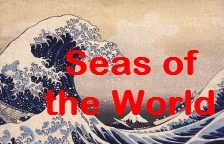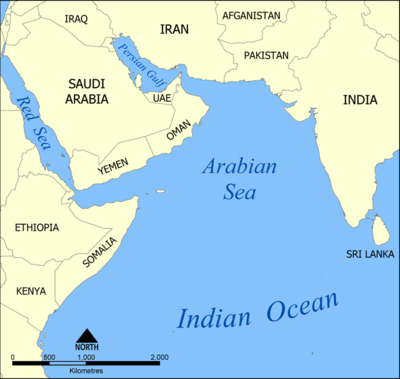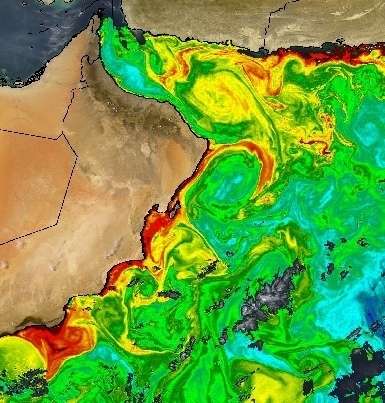Arabian Sea
Seas of the World  The Arabian Sea is a regional sea, centered at approximately 65o E and 15oN, that is bounded by Pakistan and Iran to the north, Oman, Yemen and Somalia to the west, India to the east, and the greater Indian Ocean to the south. The southern boundary, from an oceanographic point of view, runs from Goa on the Indian coast along the west side of the Laccadive Islands to the equator, and thence slightly to the south to near Mombasa on the Kenyan coast. It covers an area of about 7,456,000 km2.
The Arabian Sea is a regional sea, centered at approximately 65o E and 15oN, that is bounded by Pakistan and Iran to the north, Oman, Yemen and Somalia to the west, India to the east, and the greater Indian Ocean to the south. The southern boundary, from an oceanographic point of view, runs from Goa on the Indian coast along the west side of the Laccadive Islands to the equator, and thence slightly to the south to near Mombasa on the Kenyan coast. It covers an area of about 7,456,000 km2.
The Arabian Sea connects to the Persian (Arabian) Gulf through Gulf of Oman the Strait of Hormuz; and with the Red Sea through the Gulf of Aden and the Bel-al-Mandeb Strait. Not surprisingly, the Sea is a major trade route, particularly for oil.
Notable islands in the Arabian Sea include Socotra (actually a group of four islands) east of the Horn of Africa; and, Masirah just off the coast of Oman. The Indus River is the largest river discharging into the Arabian Sea.
Contents
Monsoon
This is one of the world's seas where monsoon weather events dominant the meteorology. For half the year (July-December), the winds in this region are from the southwest, inducing a great deal of evaporation from the warm waters of the Arabian Sea, and heavy rainfall along the coast of India. In the other half of the year, the winds blow in the opposite direction, and not as strongly as the southwest monsoon.
During the height of the Southwest Monsoon in July and August, the thick layer of clouds over the Arabian Sea makes visible remote-sensing of the sea surface by satellite-based sensors such as SeaWiFS and MODIS, virtually impossible.
But when the clouds clear in autumn, ocean color sensors reveal a roiled, colorful sea surface. The prevailing oceanic currents created by the winds of the Southwest Monsoon bring cold, nutrient-rich water to the ocean surface, fostering intense phytoplankton activity that is the base of the one of the world's last great unspoiled marine ecosystems.
Ras al Hadd Jet
The most powerful current feature in the Arabian Sea during the Southwest Monsoon is an extension of the northward flowing (from May-December) Somali Current and Oman Coastal Current. At the easternmost point of Oman—Ras Al Hadd—this current veers abruptly off the coast into the Arabian Sea, forming the Ras Al Hadd jet (also termed the Ras Al Hadd front). As the Southwest Monsoon peaks in intensity through the month of August, it significantly enhances the strength of the northward-flowing coastal current and the Ras al Hadd Jet extending into the Arabian Sea.
The largely uninhabited coastal region of Ras Al Hadd is famous for one particular reason: its pristine beaches provide a safe haven for the nests of green sea turtles that inhabit the Indian Ocean. The Ras al Hadd beaches are the largest of three main green turtle nesting areas in the Indian Ocean. The nesting season for the turtles is September to November.
The circulation pattern created by the Ras al Hadd Jet is quite obvious. During the period that the jet exists off of Oman, it creates a twin, or dipole, gyre system. The jet forms the northern boundary of a large anticyclonic (clockwise) eddy. Though phytoplankton concentrations in the jet are elevated, the concentrations in the anticyclonic eddy are low. North of the Ras al Hadd jet, a cyclonic (counter-clockwise) eddy forms, and this eddy contains higher concentrations of nutrients and phytoplankton. Late in the monsoon season, a third smaller eddy forms near the coast, forming a "tri-pole" circulation pattern.
The satellite image on the right captures a transitional period during the monsoon season. In September, the monsoon winds weaken, and this results in a corresponding decrease in the strength of the wind-forced current. As the Ras Al Hadd Jet "collapses", which can be visualized in the image as the jet curves around the anticyclonic eddy, both the cyclonic and anticyclonic eddies drift to the south.
Further to the east, in the central Arabian Sea, convoluted circulation patterns formed by the dynamic effects of the sustained monsoon winds and interwoven ocean currents seem to marbleize the ocean surface.
Arabian Sea large marine ecosystem
The Arabian Sea large marine ecosystem (LME) is characterized by its tropical climate. It encompasses three sub-regions in the Indian Ocean.
- Western Arabian Sea borders Somalia, Yemen and Oman;
- Central Arabian Sea borders Iran;
- Eastern Arabian Sea borders India and Pakistan.
Each sub-region has its own originality in terms of current patterns, physical characteristics, physiochemical qualities, dominant species and biodiversity. There is extensive interchange of surface waters in the Indian Ocean between the Arabian Sea LME and the Somali Current and Bay of Bengal LMEs. A few rivers (Indus, Euphrates and Tigris) empty into the LME.
Current fishing methods have resulted in the overexploitation of coastal resources such as sardines, prawns, pomfrets and mackerel. However, most of the fish stocks breed in deeper offshore waters so there is an opportunity to rebuild stocks. The overexploitation is mostly due to large fishing vessels that fish illegally near the coast. The market price for these species appears to be the driving factor for this overexploitation. Population expansion especially in India will continue to put pressure on coastal resources.
Species
Seasonal brown, green, and red algal flora and seasonal kelp communities, including several endemic species, represent important components of this region's biodiversity. Upwelling effects result in highly productive pelagic waters and high plankton productivity along the Oman Coast that support an enormous diversity of small herbivores.
A wide variety of invertebrates and algae exist, including Sargassopsis zanardinii , a species that is endemic to the Arabian coastline. Characteristic fishes include barracudas (Sphyraena spp.), wrasses (Family, Labridae), and damselfish (Family, Pomacentridae).
Found in the Arabian Sea are Dugong (Dugong dugon), and several species of turtles, including Green turtle (Chelonia mydas), Hawksbill turtle (Eretmochelys imbricata), and Olive ridley turtle (Lepidochelys olivacea). Of the baleen whales, recorded have been Bryde's whales (Balaenoptera edeni), Minke whales (B. acutoristrata), Fin whales (B. physalus), Blue whales (B. musculus), and Humpback whales (Megaptera novaengliae).
Toothed whales include Sperm whale (Physeter macrocephalus), Orca (Orcinus orca), and False killer whale (Pseudorca crassidens). At least a dozen species of dolphins (Family, Delphinidae) as well as the Finless porpoise (Neophocaena phocaenoides) exist in the Arabian Sea.
Further Reading
- Peter Saundry. 2011. Seas of the world. Topic ed. C.Michael Hogan.Ed.-in-chief Cutler J.Cleveland. Encyclopedia of Earth
- The Ras Al Hadd Jet: Stirring the Arabian Sea, NASA
- S. Z. Qasim. Oceanography of the northern Arabian Sea. DSR, 29:1041–1068, 1982.
- F. A. Schott and J. Fischer. Winter monsoon circulation of the northern Arabian Sea and Somalia Current. JGR, 105:6359–6376, 2000.
- Sea Process Study Web site



